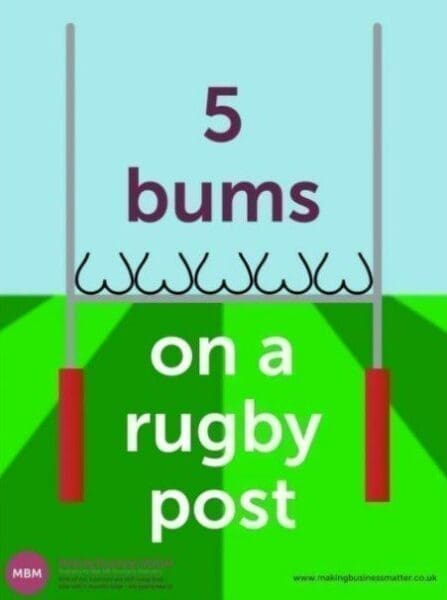Preparing For Your Negotiation by Using Powerpoint is Similar to Sellotaping a Sausage Roll to Your Stomach When You’re Hungry.
You may think that it solves the problem. It doesn’t. Don’t start preparing for negotiation with powerpoint.
Don’t Start with Powerpoint
You have a negotiation coming up, reach for Powerpoint and start typing. The first slide – the title is easy, and then you are building a presentation – a proposal, as such. Looking good, but… the problem is that this is putting you on the wrong footing, to begin your negotiation because there are 4 stages to a negotiation:
- Preparation
- Exploration
- Proposal
- Summary
By using Powerpoint you are jumping straight to stage 3 – the proposal stage. You are building your pitch/your proposal on slides, skipping stages 1 and 2 of a negotiation. Unsurprisingly most people then find themselves in a stalemate because they proposed and the other party said ‘No’. Now, you are backtracking, or holding firm – either way, your back is against the wall and left wondering, how the hell did I get here?
So, what’s the answer?
Don’t start your negotiation preparation by using the wrong tool for the job. A painter doesn’t start the wall she has to paint by reaching for a screwdriver.
So, what is the right tool?
Unfortunately, Microsoft doesn’t have the answer this time. But we do…
Use the Right Tool for the Job
‘The Squaredance‘. A simple 1-page template that encourages you to answer all the questions you need to answer in order to prepare effectively for your negotiation. The template asks you to complete the information in 6 parts:
- What is your wish? For example £10 per case, 200 stores, and no marketing budget.
- What is your walk away? For example, £9 per case, 100 stores, and £20k for marketing.
- What are your gives? For example, a free category review and p.o.s. support.
- What are your takes? For example, a meeting with the Category Director.
- What negotiating tools will you use? Up & Over, silence, and push & pull.
- What questions will you ask? For example, what is your biggest category challenge?
By completing this simple template, the squaredance, you have ‘forced’ yourself to consider your bargaining arena – wish & walk, to consider what will grease the negotiation to avoid the engine of negotiation stalling – gives & takes, and to have considered your approach – the tools & the questions.
The Wish & Walk Part of the Squaredance (Parts 1 & 2)
Be ambitious. Most negotiators are not ambitious enough. They don’t ask for more. We encourage you to do so. Though, remember, it has to be credible. Ridiculous asks will only damage your credibility.
The mnemonic I’d like to plant in your head is BOA. The ‘Big Outrageous Ask’. When you negotiate keep BOA in mind.
Sticky Learning ® is 7 times more effective than 1-day training courses. Plus, you will get a Chain of Evidence proving your Return on Investment. Discover soft skills training that changes behaviours long term.

The Gives and Takes Part of the Squaredance (Parts 3 & 4)
These are your tradeables. By having these, you can keep the negotiating moving forward, rather than butting heads on price. For example, if they want a cheaper price, you could concede if you get back one of your takes.
When you complete your squaredance template add a minimum of 7 gives and 7 takes.
The Negotiation Tools Part of the Squaredance (Part 5)
‘If you, then I’ is the most popular negotiation tool and one every negotiator should know and be able to use naturally. This tool works because it is simple and effective.
There are literally hundreds of other negotiation tools. My tip is to learn a few that you like and use them well, rather than trying to learn many and use them badly. 50 negotiation techniques available.

The Questions Part of the Squaredance (Part 6)
This part of the Squaredance template encourages us to prepare for the exploratory stage (stage 2) of a negotiation. By preparing a few open questions we can uncover a mountain of information that can help us to build the most effective proposal in stage 3 of the negotiation.
A good tip for remembering open questions is ‘5 bums on a rugby post’ – the Ws stand for What, Why, When, Who, and Where, with the H standing for How.

Feed Yourself Properly – Don’t Sellotape Sausage Rolls to Your Stomach
A slide will have encouraged you to build a pitch by sharing the reasons why. Don’t.
Firstly, you need to start with what you want, and secondly find out what they want. Then, you can go to stage 3 and make a proposal built on your needs and their needs.
Slides mean that you do not start at stage 1. It is similar to going to a car dealer and lovingly starring at the 2-seater red Porsche. The salesperson comes over and starts their patter, ‘…only two owners, one was a vicar and low mileage with a great service history’. It continues. If only they knew that you had 4 kids and whilst you’d love the sportscar, maybe one day, for now, the SUV in the corner is what you really need to buy. If only they’d asked.
The Squaredance template is the only tool you need to prepare for a negotiation. Once you have got used to it, there are 3 further uses and advantages of this simple tool, but this is advanced and not for everyone…
Are You Ready for the Advanced Squaredance?
- Once you complete your template share it with your boss because this can then be an agreement of the authority that you have. Often, when we negotiate we are not aware of how far we can go. By your line manager ‘signing off’ the squaredance he is saying that you can go as low as the walk-away. This avoids the problem of losing credibility when someone goes over your head to negotiate with your boss.
- After you have completed the Squaredance for yourself, take a fresh template and complete it for your opponent. By doing so you will ‘get into their heads’, and know where they’re coming from, which will make you a more effective negotiator because you’ll know what they want and are likely to do next. ‘Forewarned is forearmed’.
- Role play. Yes, everyone hates it. But we have a saying here at MBM World’s Stickiest Learning – ‘Sweat in training so that you don’t bleed in battle’. Give the opponent’s Squaredance to your colleague, brief them on your opponent, and then role-play. In doing so you will find corners, blind spots, and dark alleys that you never thought you would get into. Better to get into those difficult spots them with a colleague than with your opponent.
Get a Copy of the Squaredance Template
Just click on the image below to access the article where you can also download the template. It’s free.

Happy Negotiating!
P.s. You can buy a pack of our negotiation coaching cards for £11.95.
This post on Preparing for Negotiation was written by Darren A. Smith on LinkedIn.
Action: For even more useful content, check out our ultimate guide on presentation skills and negotiation skills.




